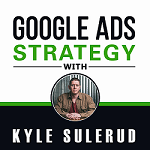This element goes into many successful ads. Do you want to discover how you can use this element in your own YouTube Ads? Do you want some examples?
Asking a question in a YouTube ad is a great way to keep the viewer engaged. It could be a yes/no question, a rhetorical question, or some question that gets the viewer to think deeply about something.
To demonstrate this, let’s take a look at several examples where the advertiser is asking the viewer a question.
*I don’t necessarily support or endorse all of the ads here. I am just using them because they are really good examples of how you can ask a question in your ads.
Example #1
This is a great example of a thought-provoking question.
“It hit me. No, I wasn’t going to become a sign spinner, but what do crazy sign-spinners have to do with passive income online?”
It’s not a question you need to answer. It’s just a question he has thought about in his mind and is trying to get the viewer to think about the same question. It then leads into the rest of the ad because now the viewer is a little more engaged.
Example #2
This example is more of a power question. Now, if you saw my videos about YouTube Ads hooks, you’ll know that one of the hooks I defined is the ‘Power Question’ hook. A power question makes a great hook but it can also be used anywhere in a video. You’re basically asking a question where the answer is going to be yes. It really helps to get the viewer on your side.
“Wouldn’t you like to have an extra couple hundred thousand dollars a year coming in working from home part-time?”
Yes, again, if I’m in that market, then my answer to that is yes. This is a great type of question to put in any YouTube ad.
Example #3
This is more of a teaser question.
“And if you’ve ever had a guy pull away from you when you wanted nothing more in the world than to have him pull you closer, it’s probably because you asked this question without even knowing it. In fact, you probably thought asking this question was a good thing even if you couldn’t be more wrong. Do you know what the question is? Let me give you a hint. The question is “_ you _ me??” Can you fill in the blanks?”
Do you know what the question is? Can you fill in the blanks? They don’t answer that question in this ad, so it keeps an open loop. It’s a teaser question because you really need to click on the ad, go to the next step to have that question answered, and to close that loop. The teaser question is a great curiosity-based question.
Example #4
Any question that is asked in a YouTube ad is a way to keep the viewer engaged. In this example, really the only purpose of these questions is to keep the viewer engaged and to keep the ad moving forward.
“So every single day, you’re like a hamster on a wheel. Reliving every single day. Can you relate? So what needs to happen for you to free yourself from yourself?”
He asks a simple yes/no question and then a question that leads into the next thing he is going to be talking about. Both of these questions are going to keep the viewer engaged. It’s very unlikely someone is going to skip the ad right there.
Example #5
This a great example of a “What if…” question. With this question, you’re saying “What if…” and then following up with some type of benefit or something that the viewer would want.
“What if you could ditch the typical learning curve and instead, experience consistent and reliable progress week after week and year after year?”
Very straightforward and actually not too difficult to work into most ads. This is very effective because it gets the viewer to start thinking about the possibilities you’re presenting to them with the ‘What if” question.
Example #6
This is an example of the buy-in question.
“Do you want to know how you can do it too?”
That’s it! You’re basically just getting the viewer’s agreement to move on to the next step and start to tell them about what it is you’re offering.
